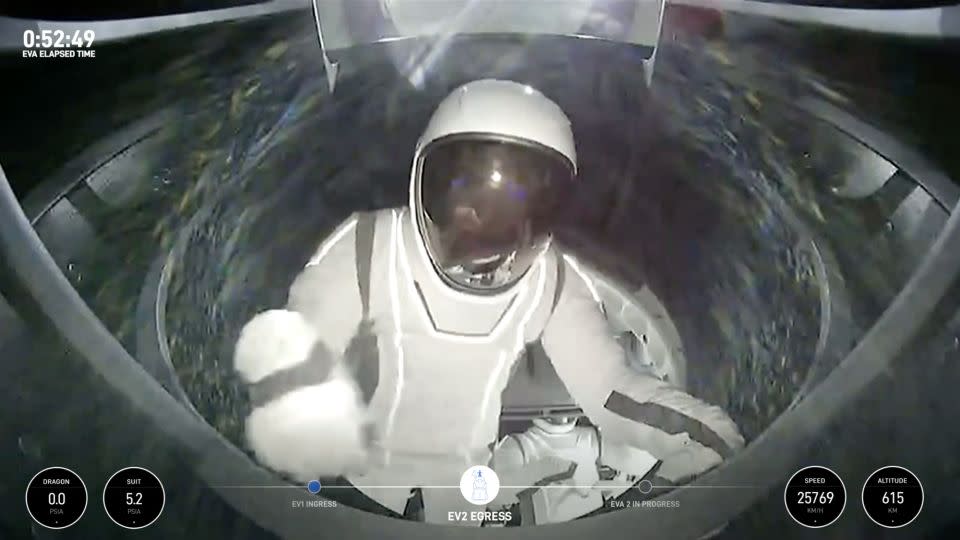Sign up for CNN’s Wonder Theory science newsletter. Explore the universe with news on fascinating discoveries, scientific advancements and more.
SpaceX’s Polaris Dawn crew is heading home, preparing to cap off a five-day mission to orbit — which included the world’s first commercial spacewalk — by splashing down in the Gulf of Mexico.
The Crew Dragon capsule carrying four astronauts is on track to land off the coast of Dry Tortugas, Florida, at 3:36 a.m. ET Sunday. SpaceX will host a livestream of the group’s return that is set to begin about an hour before splashdown.
Already, the Polaris Dawn mission has made history as it reached a higher altitude than any human has traveled in five decades. A spacewalk conducted early Thursday morning also marked the first time such an endeavor has been completed by a privately funded and operated mission.
But the trip is not over yet. And returning to Earth is among the most dangerous stretches of any space mission.
To safely reach home, the Crew Dragon capsule will carry out what’s called a “de-orbit burn,” orienting itself as it prepares to slice through the thickest part of Earth’s atmosphere.
The spacecraft will then reach extremely hot temperatures — up to 3,500 degrees Fahrenheit (1,900 degrees Celsius) — because of the pressure and friction caused by hitting the air while still traveling around 17,000 miles per hour (27,000 kilometers per hour). The crew, however, should remain at comfortable temperatures, protected by the Crew Dragon’s heat shield, which is located on the bottom of the 13-foot-wide (4-meter-wide) capsule.
Dragging against the air will begin to slow the vehicle down before the Crew Dragon deploys parachutes that will further decelerate its descent.
After hitting the ocean, the spacecraft will briefly bob around in the water as rescue crews waiting nearby prepare to haul it out of the ocean and onto a special boat, referred to as the “Dragon’s nest.” Final safety checks will take place there before the crew can disembark from the capsule and begin the journey back to dry land.
A historic flight
The Polaris Dawn crew includes mission commander Jared Isaacman, the billionaire CEO of the finance company Shift4 Payments; his close friend and former US Air Force pilot Scott “Kidd” Poteet; and SpaceX operations engineers Anna Menon and Sarah Gillis.
The quartet kicked off this mission by breaking an altitude record, reaching an orbit around Earth that extended as high as 870 miles (1,400 kilometers). That’s the highest Earth orbit ever traveled by humans, beating a 1966 record set by NASA’s Gemini 11 mission, which reached 853 miles (1,373 kilometers).
The crew’s apogee — or farthest point from Earth — made Gillis and Menon the first women ever to fly so far from our planet.
The apogee also marked the farthest any human has journeyed since NASA’s Apollo Program ended in 1972.
The Crew Dragon capsule then lowered its altitude to carry out the spacewalk.


The high-risk event, also called an extravehicular activity or EVA, saw the Crew Dragon capsule become entirely depressurized before Isaacman opened the hatch, exposing the group to the vacuum of space.
Isaacman and Gillis exited the vehicle for roughly 10 minutes each, carrying out a series of tests to understand the functionality of the EVA suits, before retreating inside the Crew Dragon spacecraft and latching the hatch.
The spacewalk appeared to go off without any major issues. Isaacman reported after taking his first glimpse outside the spacecraft, “Back at home we all have a lot of work to do, but from here — looks like a perfect world.”
The remainder of the crew’s time in orbit has been spent carrying out nearly 40 science experiments and research, including some that sought to better understand space adaptation syndrome — a type of microgravity-specific motion sickness.
Gillis, a trained violinist, also brought her instrument along for the mission and delivered a rendition of “Rey’s Theme” from “Star Wars: The Force Awakens.” Gillis’ music was sent back to Earth using SpaceX’s Starlink as a test of the satellite network’s potential to provide in-space connectivity.
Menon also took time to read a book she coauthored — called “Kisses From Space” — to her family as well as a group of patients from St. Jude Children’s Hospital as part of a fundraiser.
Sunday’s anticipated return will mark the conclusion of the third trip to space for the specific Crew Dragon capsule powering the Polaris Dawn mission.
The spacecraft — named “Resilience” by the NASA astronauts onboard its first trip to space in November 2020, called Crew-1 — flew the 2021 Inspiration 4 mission. That trip, also funded by Isaacman, saw him and three crewmates circle Earth for three days as part of a fundraiser for childhood cancer research.
For more CNN news and newsletters create an account at CNN.com
